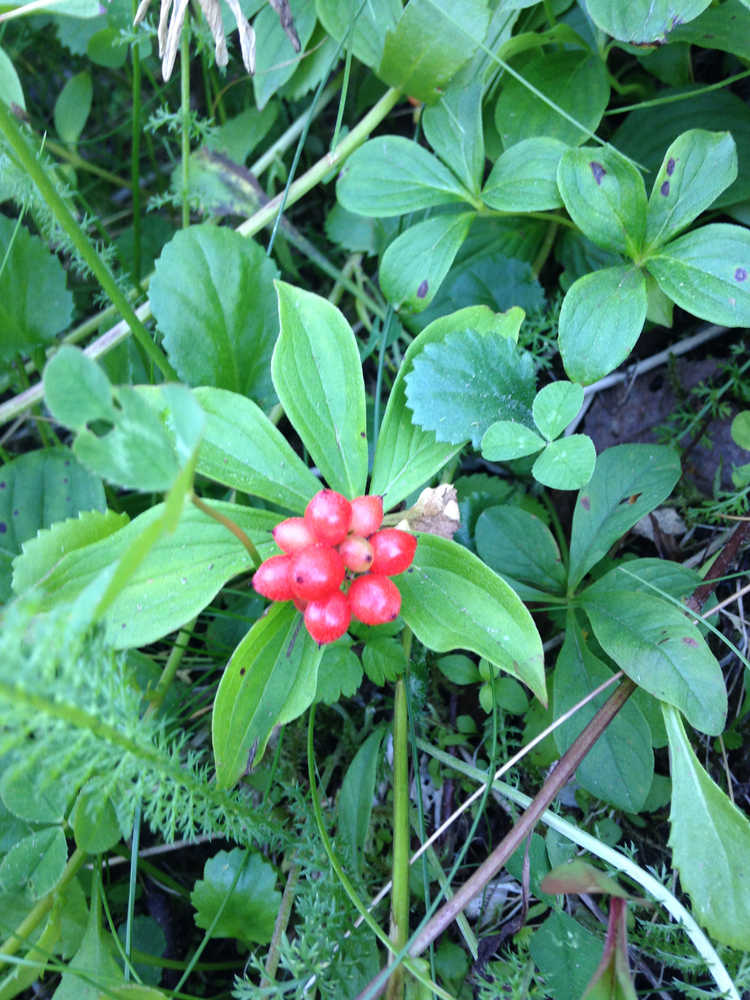Like gardeners, foragers are willing to share ideas. They might not be quick to reveal their favorite harvesting spots, but they do talk about what they pick, when they pick, and what they do with it.
At the Juneau Arts and Humanities Council’s end-of-summer Food Festival, I was reminded of the importance of trading information. I knew bunchberries, also known as dwarf dogwood berries, were high in pectin, but I hadn’t used them in that way. Then a person mentioned how she had collected a bagful in case she couldn’t find crab apples. Suddenly it seemed more doable to utilize this abundant berry.
The following day, the Juneau Cooperative Extension Office’s final feasting and foraging class of the year experimented while making a thimbleberry freezer jam. We used bunchberries in one batch and just plain thimbleberries in another. The end tastes were very similar, but the one with bunchberries was clearly thicker.
Pectin is a natural substance found in fruits and berries. When combined with sugar and heat, it has a starch-like property. Unlike the commercial variety, using fruit high in pectin to bind the jelly together gives you the opportunity to decrease the amount of sugar while still maintaining the desired thickness. Another method that uses less sugar is to cook berries down until they thicken into jam, but it takes a while and involves stirring over a hot stovetop, which makes it seem even longer.
Crab apples (malus fusca) and bunchberries (cornus Canadensis) are the two fruits in Southeast that are the highest in pectin. On the opposite side of the spectrum, blueberries and cherries need additional pectin in order to jell.
Because pectin amounts vary from fruit to fruit and decrease over time as the berry ripens, the best way to determine the correct amount is to bring your jelly-in-progress to a boil and then scoop out some of it with a spoon. Sit the spoon on an ice cube. If it’s the right consistency, it will jell. If it’s too thin — more liquid than solid — add more fruit or sugar, bring it to a boil for an additional minute, and test again.
Unlike more commonly consumed apples, the Pacific crabapple likes a wetter location, often on the edge of the muskeg. The apples hang down from stems in clusters. Even when they are fully ripe, the apples are tart. For use as a pectin, you’ll want to pick them early.
Bunchberries seem to like every habitat, from wetter areas to woodlands. I think the berries don’t have much of a taste, although my daughters and her friends disagree. At one time, they claimed it was their favorite berry.
The plants form four white bracts — specialized leaves that are not flowers. Instead the cluster of flowers lies within, waiting to open and release the pollen. Like a miniature trebuchet, it waits for a larger insect such as a bee or beetle to trigger the spring, launching the pollen at a speed 800 times faster than the acceleration astronauts feel at liftoff according to a 2005 article in “Nature” magazine.
A brief comment about how valued bunchberries were led me to reconsider both the bunchberry and crab apple in terms of how I view them. I have to say that I am going to be keeping a close eye on them as the flowers develop. Even though I know it would be impossible for me to see this pollen explosion, I’ll be imagining it as I walk down a path amid bunchberries.
• Corinne Conlon is a freelance writer based out of Juneau. She can be reached at dirtgirlgardening@gmail.com.

